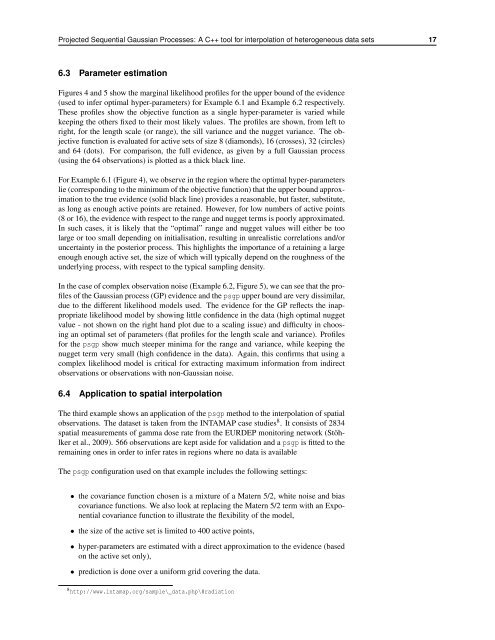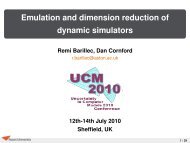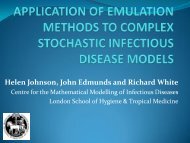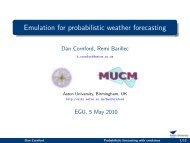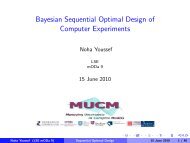Projected Sequential Gaussian Processes: A C++ tool for ... - MUCM
Projected Sequential Gaussian Processes: A C++ tool for ... - MUCM
Projected Sequential Gaussian Processes: A C++ tool for ... - MUCM
You also want an ePaper? Increase the reach of your titles
YUMPU automatically turns print PDFs into web optimized ePapers that Google loves.
<strong>Projected</strong> <strong>Sequential</strong> <strong>Gaussian</strong> <strong>Processes</strong>: A <strong>C++</strong> <strong>tool</strong> <strong>for</strong> interpolation of heterogeneous data sets 17<br />
6.3 Parameter estimation<br />
Figures 4 and 5 show the marginal likelihood profiles <strong>for</strong> the upper bound of the evidence<br />
(used to infer optimal hyper-parameters) <strong>for</strong> Example 6.1 and Example 6.2 respectively.<br />
These profiles show the objective function as a single hyper-parameter is varied while<br />
keeping the others fixed to their most likely values. The profiles are shown, from left to<br />
right, <strong>for</strong> the length scale (or range), the sill variance and the nugget variance. The objective<br />
function is evaluated <strong>for</strong> active sets of size 8 (diamonds), 16 (crosses), 32 (circles)<br />
and 64 (dots). For comparison, the full evidence, as given by a full <strong>Gaussian</strong> process<br />
(using the 64 observations) is plotted as a thick black line.<br />
For Example 6.1 (Figure 4), we observe in the region where the optimal hyper-parameters<br />
lie (corresponding to the minimum of the objective function) that the upper bound approximation<br />
to the true evidence (solid black line) provides a reasonable, but faster, substitute,<br />
as long as enough active points are retained. However, <strong>for</strong> low numbers of active points<br />
(8 or 16), the evidence with respect to the range and nugget terms is poorly approximated.<br />
In such cases, it is likely that the “optimal” range and nugget values will either be too<br />
large or too small depending on initialisation, resulting in unrealistic correlations and/or<br />
uncertainty in the posterior process. This highlights the importance of a retaining a large<br />
enough enough active set, the size of which will typically depend on the roughness of the<br />
underlying process, with respect to the typical sampling density.<br />
In the case of complex observation noise (Example 6.2, Figure 5), we can see that the profiles<br />
of the <strong>Gaussian</strong> process (GP) evidence and the psgp upper bound are very dissimilar,<br />
due to the different likelihood models used. The evidence <strong>for</strong> the GP reflects the inappropriate<br />
likelihood model by showing little confidence in the data (high optimal nugget<br />
value - not shown on the right hand plot due to a scaling issue) and difficulty in choosing<br />
an optimal set of parameters (flat profiles <strong>for</strong> the length scale and variance). Profiles<br />
<strong>for</strong> the psgp show much steeper minima <strong>for</strong> the range and variance, while keeping the<br />
nugget term very small (high confidence in the data). Again, this confirms that using a<br />
complex likelihood model is critical <strong>for</strong> extracting maximum in<strong>for</strong>mation from indirect<br />
observations or observations with non-<strong>Gaussian</strong> noise.<br />
6.4 Application to spatial interpolation<br />
The third example shows an application of the psgp method to the interpolation of spatial<br />
observations. The dataset is taken from the INTAMAP case studies 8 . It consists of 2834<br />
spatial measurements of gamma dose rate from the EURDEP monitoring network (Stöhlker<br />
et al., 2009). 566 observations are kept aside <strong>for</strong> validation and a psgp is fitted to the<br />
remaining ones in order to infer rates in regions where no data is available<br />
The psgp configuration used on that example includes the following settings:<br />
• the covariance function chosen is a mixture of a Matern 5/2, white noise and bias<br />
covariance functions. We also look at replacing the Matern 5/2 term with an Exponential<br />
covariance function to illustrate the flexibility of the model,<br />
• the size of the active set is limited to 400 active points,<br />
• hyper-parameters are estimated with a direct approximation to the evidence (based<br />
on the active set only),<br />
• prediction is done over a uni<strong>for</strong>m grid covering the data.<br />
8 http://www.intamap.org/sample\_data.php\#radiation


